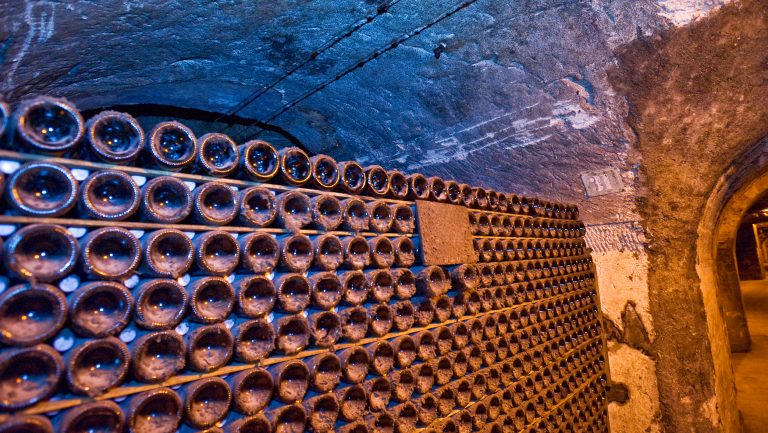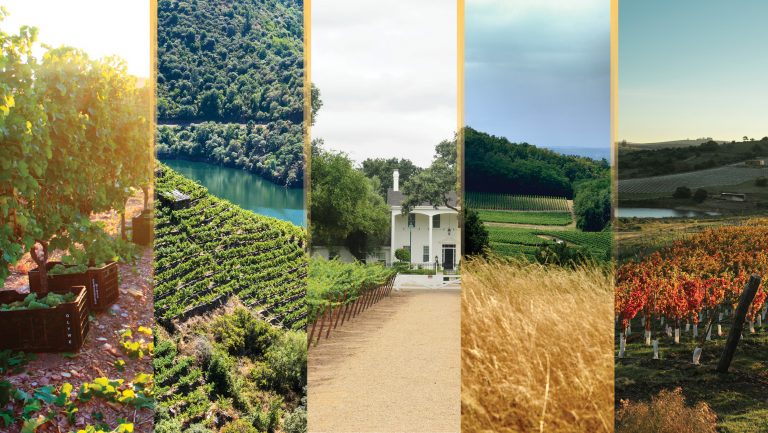At a vertical tasting of Grand Vin du Château Margaux this March, Aurélien Valance, deputy general manager of the First Growth winery, raised a glass of the 1996 vintage and confessed, “I was going to be an investment banker.” Valance had been studying for a business degree in 2001 when Château Margaux owner Corinne Mentzelopoulos conducted a tasting at his school. “She chose the ’96 to finish with,” he said. “I fell in love with the wine and asked her for an internship. Without it, I wouldn’t be in this position today.”
At 21 years old, the wine we tasted was still in its prime: powerful and perfumed, with balanced acidity and velvety tannins. Up against the softer 1990, tight-knit 2005, and young-but-pretty 2009, the ’96 showed the evolution of Premier Cru Bordeaux, with their slow yielding to age punctuated by the personality of each harvest.
Valance’s anecdote exemplified the storytelling that a library—a winery’s collection of older vintages—brings to branding. But a library provides more than marketing mystique. At Château Margaux, where winemakers taste vintages from 1970 on up at least once a year, these bottles offer a chance to learn from the past and to tweak practices to address similar climatic conditions in future years.

Don’t miss the latest drinks industry news and insights. Sign up for our award-winning newsletters and get insider intel, resources, and trends delivered to your inbox every week.
This consistent tasting proves to be a resource for collectors, too. On its website, Château Margaux has an archive of notes on the weather and harvest for each vintage, along with updates on the evolution of the wines each year, going so far as to make comparisons across vintages. A quick read shows that the 1900 “still has an extraordinary freshness,” for instance, and that the 2000 turned out to be of a similar quality.
Château Margaux stores 20 percent of each vintage, or 25,000 bottles—more in better years—in a climate-controlled cellar at the château that holds bottles dating to 1848. The winery earmarks about 90 percent of those for later sales, priced according to age and availability. The fairly plentiful 1982 can currently be purchased for €1,800 a bottle, for example, while an 1868 went for €100,000 at a 2011 auction to provide disaster relief for Fukushima, Japan. The remainder of Château Margaux’s library is kept to be tasted or opened at winery events—eventually.
“Absolutely the library is key because our wines can age sometimes as much as a century,” Valance says. “If you don’t keep enough old vintages, you can’t show maturity.”
Storytelling, record keeping, appreciation in value, and establishment of a legacy—all these are at the core of a good library program. And the decisions that go into the management of a library can be fundamental to the well-being of a winery. Even in younger regions, the practice is gaining in importance as wine lovers seek the access and knowledge that winery libraries offer.
From Family Cache to Formal Program
When the Mondavi family renovated the Charles Krug Winery in 2013 (they’ve been owners since 1943), they looked at the seven decades of Vintage Selection Cabernets they’d been holding onto almost sentimentally and saw the inventory anew. “In the earlier years, we just felt we should have something to revisit in the future,” says Peter Mondavi, Jr., third-generation co-owner, along with his brother, Marc. They’d been keeping anywhere from 50 to 100 cases a year, opening some from time to time for vertical tastings—“to indoctrinate sommeliers to our older wines,” for example—but they were mainly “seeding and not taking much out.” With the uptick in the trend toward direct-to-consumer sales, the library is becoming more important to Krug’s business.
This year Charles Krug added a Prestige Library level to its wine club program; it’s limited to 50 members who, in addition to their usual allocations, get two shipments a year of two or three bottles of older wine. Members also receive an invitation to a winery dinner where Mondavi pours past vintages.
Currently, the winery is moving vintages as far back as the 1970s. For now, the wines are available only to club members. Mondavi prices them according to quality, quantity, age, and the vintage’s original reviews, putting a $338 price tag on the 1974, known as an excellent growing year, and $232 on the 1983, when a wet winter and heat-stressed harvest made for a difficult vintage for Napa. Once these run low, the remainder will be reserved for vertical tastings with trade or press. When a vintage is reduced to one case, says Mondavi, “we just throw away the key,” leaving the wine to be opened with collectors in the distant future or not opened at all.
Building a Library to Build a Reputation
In Napa or Bordeaux, where rare Cabernets command tremendous prices, decades of cellaring might make sense, but how about in regions that have less-established reputations? Roman Roth and I sat in a chilly room tucked in the cellar at Wölffer Estate Vineyard in Southampton, on New York’s Long Island. All around us, bottles of Wölffer Chardonnay, Pinot, Merlot, and botrytised dessert wine were resting on shelves. Roth, the winemaker, was reminiscing. “One of the best wines I ever made was the ’95 Pinot Noir,” he says. “I only made one magnum. Last year we opened it, and it was unbelievable. It shocked people.”
It was the boasting of man out to prove the aging potential of Long Island wines. Built into the original design of the winery in 1997 and filled at first with Grand Cru Burgundies as placeholders for the Wölffer wines that would eventually take their place, the library is part of Roth’s master plan.
“I started here in 1992,” says Roth. “It was the worst year. We had 13 rainy weekends. Then 1993 was a dream year, 1994 was fantastic for whites, ’95 was [a] dream year, ’97 was a dream year. So from those years, we had Chardonnay that could age.”
Roth says Long Island’s cool climate and ocean breezes mean that well-tended clusters develop the acidity to give the wines lasting power. But for an emerging region that has seen its share of growing pains, it has been an uphill battle to have the wines taken seriously. The Wölffer library helps. “It sets us apart—that this aim for longevity is a real plan,” says Roth. Of the 61,000 cases of wine Roth makes annually, he calculates that 9,000 have significant aging potential, and of those he reserves 100 cases a year for the library.
Roth poured me a glass of his Perle Chardonnay, a barrel-fermented estate selection, from 1998. With age, it had taken on a deep, golden hue, and if its nose was fading, its freshness was still intact. “It’s one of our dreams,” Roth says, “that we would be the first Long Island winery at the Sotheby’s auction one day with collectors of these wines.”
Roth can dream this big because his business model supports it. As a winery in a beach destination, Wölffer has a moneymaker in summer’s drink-now rosé. Roth makes 45,000 cases of it annually, and thanks to its popularity he can afford to spend $200 to $300 more per ton on tending to grapes for his library wines.
The rosé also offers a point of entry for buyers, allowing them to become interested in Wölffer’s older wines. Says Roth, “A vibrant, young customer who is excited about your program is important to a winery.”
Save from the Start
Of course, not every winery has the means to stash wine in cellars from the get-go; it’s a considerable investment for a winery to make. When Andy Erickson and Annie Favia, owners of Napa’s 15-year-old Favia Wines, sought to establish a library a few years into their production, they found themselves having to buy back wines from trusted sources on WineBid to stock it. They had sold everything they had made. “Basically, we needed the money at the beginning,” says Erickson, “so it was hard to lock anything away.”
Now that their brand has matured and their production increased, they can afford to hold back wine. Of the 250 to 400 cases of Napa and 150 to 200 cases of Amador County reds they make, they keep 25 cases of 750s and a few cases of magnums each, storing them along with the rest of their inventory in a temperature-controlled off-site warehouse. Leasing space costs money, but Erickson knows it’s worth it. He’ll open older bottles at dinners and tastings to highlight their ageability.
And then there’s the very practical aspect of being able to check on their work. “It’s really nice to go back to wines made from the same vineyards we’re still working with and see that they’re showing well,” says Erickson. “It’s fun to share that. Every year is different, so it’s interesting to see how things evolve.”
That was the goal all along, and now that he’s achieved it, Erickson offers a word of advice for up-and-coming winemakers: “It’s easy when you’re an upstart and have bills to pay to seize on that inventory, but try to avoid the temptation to sell every single bottle.”

Dispatch
Sign up for our award-winning newsletter
Don’t miss the latest drinks industry news and insights—delivered to your inbox every week.
Betsy Andrews is an award-winning journalist and poet. Her latest book is Crowded. Her writing can be found at betsyandrews.contently.com.







